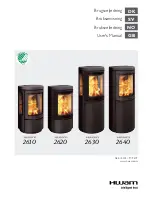
3
Warning!
The multi-fuel stove may not be used in
combined operation with air ventilation devices in your
house or apartment.
The
operation of this stove is not compromised, if the
devices just circulate air within a room, or if the devices are
fitted with safety systems which automatically and reliably
prevent low pressure forming in the room in which the stove
is sited. It is essential that you make sure that you have a
sufficient supply of air for combustion by checking with
your master chimney sweep.
Heat energy is released by burning combustible materials,
which leads to the surfaces of the stove being heated up
strongly (the doors, door handles, the operating controls, the
transparent windows, the side walls, the front wall and the
exhaust flue). Avoid touching these parts without wearing
appropriate heat resistant gloves! A heat resistant glove is
provided with this multi-fuel stove.
Do not wear any loose or flammable articles of clothing
when adding fuel to your multi-fuel stove!
Make children aware of these dangers and keep them away
from the stove when it is producing heat.
If incorrect or damp fuels are used, then a chimney fire may
occur because of deposits in the chimney. Close all air
openings in the stove and inform the fire brigade. After the
fire in the chimney has been extinguished have the chimney
professionally examined for any cracks or leaks.
Warning!
Never operate the multi-fuel stove without
water and never without a functional cold water supply
and the operation of the temperature limiting device and
the accompanying safety controls.
Otherwise there is a risk of an explosion leading to
irreparable damage!
3. Data for calculating the chimney dimensions
according to DIN 4705 Part 2
The data for calculating the chimney dimensions according
to DIN 4705 Part 2 can be found in the accompanying
device information sheet.
4. Installation and connection of the multi-fuel
stove
The packaging of your new multi-fuel stove provides the
optimum protection against damage. During transport
damage can still occur to your stove or its accessories.
Please examine your multi-fuel stove after you have
unpacked it for damage and completeness! Immediately
report any defects to your stove dealer!
Note: Draught deflector plates or similar which are loose or
have slipped out of their positions are not considered to be a
defect (see section 5.3: Using your chimney for the first
time).
The packaging of your multi-fuel stove is to a large extent
environmentally neutral. The wood of your packaging is not
surface treated and can be used as a fuel when chopped up
into small pieces. The cardboard and the film can be sent to
the local recycling centre without any problems.
4.1. Safe distances (minimum distances):
When installing your multi-fuel stove the officially
prescribed fire protection regulations must be strictly
followed. Ask your local master chimney sweep if you have
any questions about them.
The following minimum distances from flammable or
temperature sensitive materials (e.g. furniture, wallpaper,
wooden panelling) or from load-bearing walls must be
complied with (see diagram below):
A 20 cm to the rear wall
B 20 cm to the side walls
C 80 cm in the radiation area
In the radiation area (C) no flammable building components
or furniture should be placed within a distance of 80cm from
the transparent window. This distance can be reduced to
40cm if a radiation protection plate that is well-ventilated on
both sides is placed between the stove and the flammable
building components.
The minimum distances to flammable building components
and furniture are given on the specification plate and should
not be any less than these values.
With flammable or heat sensitive floor-coverings the device
must be placed on a non-flammable protective base plate
(e.g. steel sheet, glass). The minimum distances are then (see
diagram):
D
50cm
E
30cm (from the inner edge of the opening to the
combustion chamber)
We stock protective base plates as part of our accessories
programme. If necessary you can order them from your stove
dealer.
4.2. Connection to the chimney
For connecting the stove to the chimney a flue tube made
from 2mm thick steel tubing should be used.
The flue tube should be tightly and securely connected to not
only the exhaust gas connecting piece, but also to the
chimney. Tight and secure connection is also necessary
between the flue elements. It is essential to make sure that
the flue tube does not extend into the empty section of the
























